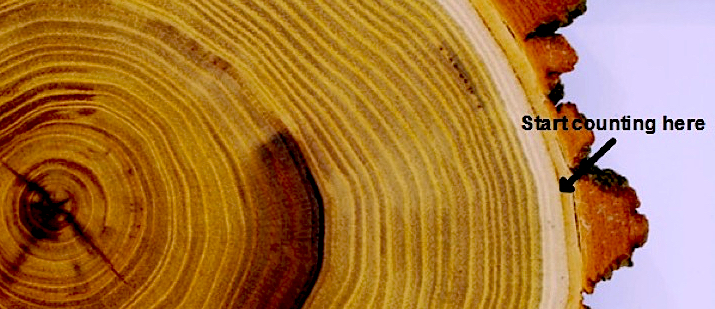Knauss legislative fellowships in Congress help build careers — and they're fun and educational. See our video and fact sheet for details.
Dendroclimatology
School:
Carroll County Public Schools, Maryland Sea Grant, and University of Maryland ExtensionLesson Summary
Dendrology is the scientific study of trees; dendrochronology is the study of tree-ring dating and dendroclimatology is analyzing tree rings to estimate past climates. Students will be introduced to dendrochronology and, more explicitly, dendroclimatology in this series of lessons. The lesson starts by engaging students in background information on tree rings and related terminology. Students will calibrate and use Image J computer software from the National Institute of Health (NIH) to complete a practical measurement activity followed by tree ring width measurements of a known tree cross section.
 Photo credit: Cherry tree cross section. Shelby Sawyers, Northwest Middle School, Carroll County Public Schools.
Photo credit: Cherry tree cross section. Shelby Sawyers, Northwest Middle School, Carroll County Public Schools.
Students will correlate measurement results to precipitation data from National Oceanic and Atmospheric Administration (NOAA) to make climate predictions. Data collected will be used to compose a multi-axis graph for climate analysis. The summative assessment will ask students to apply their new knowledge and skills to collect the necessary measurements from an American chestnut sample to compare with corresponding precipitation data, graph it, and complete analysis questions.
Background information about the American chestnut:
Teacher references:
Synthesis of American chestnut (Castanea dentata) biological, ecological, and genetic attributes with application to forest restoration by Douglass F. Jacobs, Harmony J. Dalgleish, C. Dana Nelson. Posted with permission from D.F. Jacobs, 9/2/2015.
A New Generation of American Chestnut Trees May Redefine America's Forest by F. Jabr. Scientific American Vol. 310, Issue 3, Web Exclusives.
American chestnuts rise where other trees failed to make a stand by Leslie Middleton. Bay Journal, October 28, 2015.
The American Chestnut and Climate Change by Phil Taylor. Scientific America, July 1, 2009.
Student references:
A New Generation of American Chestnut Trees May Redefine America's Forest by F. Jabr. Scientific American Vol. 310, Issue 3, Web Exclusives.
Synthesis of American chestnut (Castanea dentata) biological, ecological, and genetic attributes with application to forest restoration by Douglass F. Jacobs, Harmony J. Dalgleish, C. Dana Nelson. Posted with permission from D.F. Jacobs, 9/2/2015.
Driving Questions
How can the subject of dendroclimatology be used to reveal historical changes in a climate?
5E For This Lesson Plan
Exploration
Exploration
In this section students are given time to think, plan, investigate, collect and organize information.
Tree Ring Exploration
Students will:
- Be able to date a tree using a cross-section image to practice counting rings.
- Describe which type of cells become the “wood” of a tree and which type of cells become the bark of the tree.
- Describe the types of wood produced by trees depending upon seasonal conditions.
Calibration and Measurement Training Exercise
Students will:
1. Calibrate the ImageJ application to prepare for measurement practice.
2. Demonstrate the proper use of technology in data collection.
Cross Section Analysis
Students will:
- Demonstrate the ability to calibrate and prepare the ImageJ application for measurement.
- Demonstrate the proper use of technology to collect data on a cherry tree cross section.
Comparing Tree Rings and Precipitation
Students will:
- Be able to appropriately graph data related to dendrochonology measurements from the Cross Section Analysis activity and precipitation data from the NOAA Climate at a Glance website.
- Make observations of NOAA data and tree-ring data and describe/illustrate any correlation.
Evaluation
Evaluation
This performance-based activity helps students to connect all of the pieces of information involved in these lessons.
Connecting Precipitation and Tree Ring Data
Students will:
- Demonstrate the ability to identify and describe if a correlation exists between annual precipitation and tree ring growth using skills and tools developed through the activities in Dendroclimatology.





